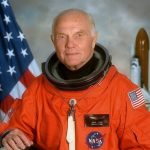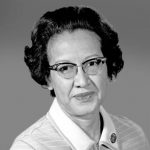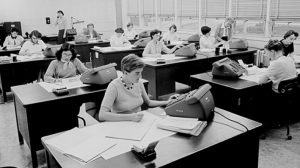human computers

 Most of us who were around in the 1960s, know about the early space program, and especially the very first American to orbit the Earth…John Glenn. John Glenn’s historic flight put the United States on the map of the space race, so to speak. It all seems very commonplace in this day and age of space shuttles, and the International Space Station, but the reality was that this first American orbit could have ended tragically.
Most of us who were around in the 1960s, know about the early space program, and especially the very first American to orbit the Earth…John Glenn. John Glenn’s historic flight put the United States on the map of the space race, so to speak. It all seems very commonplace in this day and age of space shuttles, and the International Space Station, but the reality was that this first American orbit could have ended tragically.
While some change had happened concerning blacks and women, there was still much that had not changed. Women were not viewed as mathematically inclined, and black women even less so. That was before they knew about Katherine Johnson. Katherine Johnson was handpicked to be one of three black students to integrate West Virginia’s graduate schools. Born in White Sulphur Springs, West Virginia in 1918, her intense curiosity and brilliance with numbers vaulted her ahead several grades in school. She graduated from high school at the age of 14, and the historically black West Virginia State University at 18, where she had made quick work of the school’s math curriculum. Katherine graduated with highest honors in 1937 and took a job teaching at a black public school in Virginia, but this was not to be her career.
In 1935, the NACA (National Advisory Committee for Aeronautics, a precursor to NASA) hired five women to be their first computer pool at the Langley campus. “The women were meticulous and accurate…and they didn’t have to pay them very much,” NASA’s historian Bill Barry says, explaining the NACA’s decision. Six months later, after the attack on Pearl Harbor brought the United States into World War II, NACA and Langley began recruiting African-American women with college degrees to work as human computers.
Johnson was hired by NACA in 1953. Johnson, along with Dorothy Vaughan, and Mary Jackson, became part of NASA’s team of human computers. These people were mathematicians who performed the necessary calculations to make space flight possible in a time when “machine computers” didn’t exist, or were very new. Johnson was perfect for this job. After working for Nasa a while, and really proving her worth, Johnson was still running into road blocks. When NASA engineer Paul Stafford was preparing a meeting about John Glenn’s upcoming mission. Johnson felt that she needed to be at that meeting to explain her numbers, but Stafford refused her the request to attend stating, “There’s no protocol for women attending.” Johnson instantly replied, “There’s no protocol for a man circling Earth either, sir.”
Johnson saw an opportunity when NASA installed huge IBM computers…that no one knew how to use. They tried to get the machines set up so that the human computers could be replaced by the far more accurate machines, but the set up proved too difficult, until Johnson taught herself to use the machines. She then taught the rest of the black women, human computers to run them too. In the end, they were the only ones who knew how to do it. It made them much more important to the space program. The men had to face the fact that the women, that they had all but discounted, were going to be the ones to save the space program.
The biggest highlight of Katherine Johnson’s career came at the point when John Glenn was getting ready to  make that historic first orbit around the Earth. Johnson’s main job in the lead-up and during the mission was to double-check and reverse engineer the newly-installed IBM 7090s trajectory calculations. There were very tense moments during the flight that forced the mission to end earlier than expected. John Glenn requested that Johnson specifically check and confirm trajectories and entry points that the IBM put out. Glenn didn’t completely trust the computer. So, he asked the head engineers to “get the girl to check the numbers…If she says the numbers are good…I’m ready to go.” Johnson couldn’t have been given a greater seal of approval than to have John Glenn say that she was the only one he trusted…after all, it was his life.
make that historic first orbit around the Earth. Johnson’s main job in the lead-up and during the mission was to double-check and reverse engineer the newly-installed IBM 7090s trajectory calculations. There were very tense moments during the flight that forced the mission to end earlier than expected. John Glenn requested that Johnson specifically check and confirm trajectories and entry points that the IBM put out. Glenn didn’t completely trust the computer. So, he asked the head engineers to “get the girl to check the numbers…If she says the numbers are good…I’m ready to go.” Johnson couldn’t have been given a greater seal of approval than to have John Glenn say that she was the only one he trusted…after all, it was his life.
 When we think of computers, most of us think of the modern day laptop, or even our smart phones, and when we think of who invented the computer, we think of a man, and that would probably be right, but when NASA thinks of computers, they also have to include the Women of NASA. They were known as “human computers” long before desktop, laptops, or even multi-function calculators existed. Barbara “Barby” Canright joined California’s Jet Propulsion Laboratory in 1939. She was the first female “human computer” and her job was to calculate anything from how many rockets were needed to make a plane airborne to what kind of rocket propellants were needed to propel a spacecraft. She did her calculations by hand, with only a pencil and graph paper. It often took more than a week to complete, and her work commonly filled six to eight notebooks with data and formulas. After the Japanese attack on Pearl Harbor, her work, along with that of her mostly male teammates, took on a new meaning. There was important work to be done to secure the safety of our nation. The army needed to lift a 14,000 pound bomber into the air, and Barby was responsible for determining the thrust-to-weight ratio and comparing the performance of engines under various conditions, so they could make that happen. Due to the amount of work it was going to take to accomplish this task, more “computers” were hired, including three women Melba Nea, Virginia Prettyman and Macie Roberts.
When we think of computers, most of us think of the modern day laptop, or even our smart phones, and when we think of who invented the computer, we think of a man, and that would probably be right, but when NASA thinks of computers, they also have to include the Women of NASA. They were known as “human computers” long before desktop, laptops, or even multi-function calculators existed. Barbara “Barby” Canright joined California’s Jet Propulsion Laboratory in 1939. She was the first female “human computer” and her job was to calculate anything from how many rockets were needed to make a plane airborne to what kind of rocket propellants were needed to propel a spacecraft. She did her calculations by hand, with only a pencil and graph paper. It often took more than a week to complete, and her work commonly filled six to eight notebooks with data and formulas. After the Japanese attack on Pearl Harbor, her work, along with that of her mostly male teammates, took on a new meaning. There was important work to be done to secure the safety of our nation. The army needed to lift a 14,000 pound bomber into the air, and Barby was responsible for determining the thrust-to-weight ratio and comparing the performance of engines under various conditions, so they could make that happen. Due to the amount of work it was going to take to accomplish this task, more “computers” were hired, including three women Melba Nea, Virginia Prettyman and Macie Roberts.
It was a time when women were mostly homemakers, and in fact, often looked at as probably not able to understand complicated things like math, science, and engineering, but times were changing. We were a nation at war, and many of the men were fighting. Not only did the women step up to the plate, but they showed that they could understand the work they did, as well as, if not better than their male counterparts. In fact, they did their work so well, that their calculations would end up charting the course of many ground breaking missions that would carry United States astronauts to the moon and beyond. These women were an elite team of mathematicians, engineers and scientists, who were tasked with turning numbers into meaningful data at what would later become NASA’s Jet Propulsion Laboratory and Langley Research Center. They challenged NASA to let them show what they could do, and when NASA did so, they really shined. It was an eye-opening accomplishment, and one that I’m pretty sure many men thought couldn’t be done.
It’s a funny thing, in my mind, that they were called “human computers” though. I suppose the work they did was computing, but the terminology just seems odd. These days, we talk about someone having the mind of a computer, but we don’t call them a computer. I guess that’s because we have computers, and no one would think of a person in that way. The reality is that, while these women were breaking ground in previously uncharted territory, their services would never really become unnecessary. In fact, one of the earliest human computers still works at Jet Propulsion Laboratory. Sue Finley is 80 now, and NASA’s longest serving female employee. She was originally hired in 1958 to work on trajectory computations for rocket launches, and is now  a software tester and subsystem engineer. She is currently working on NASA’s mission to Jupiter. Her legacy, and that of the other early human computers, is literally written in the stars. What really amazes me is that many people over 70 have no idea how to work a computer, and yet here is this 80 year old woman who is a software tester and subsystem engineer. Amazing!! Totally amazing!!
a software tester and subsystem engineer. She is currently working on NASA’s mission to Jupiter. Her legacy, and that of the other early human computers, is literally written in the stars. What really amazes me is that many people over 70 have no idea how to work a computer, and yet here is this 80 year old woman who is a software tester and subsystem engineer. Amazing!! Totally amazing!!

